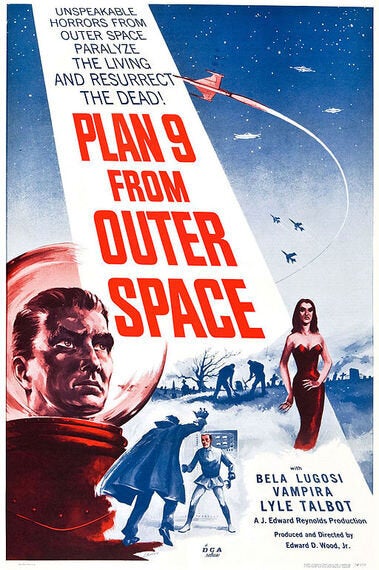A small but growing number of film clubs around Britain are intent on celebrating the most spectacular "so-bad-they're-awesome" cinematic misadventures.
You may never have heard of Black Samurai, Hercules in New York or Troll 2 but the titles alone give you an idea of the sort of unintentionally hilarious movies showcased by the likes of Bristol Bad Film Club, the Crap Film Club in London and Sheffield's Five and Dime Picture Show, where cult movie fans get together to laugh and shout at a gamut of dramatic misfires which would be unbearably bad viewed alone.
So how do you achieve a film that's so gobsmackingly-awful it's actually quite brilliant? Here are seven simple rules, curated with the help of Bristol Bad Film Club co-founder Timon Singh.
1. The first rule of bad film club is you do not try to be in bad film club
You've probably already ruined your chances of making a so-bad-it's-good hit by reading this far. Entertainingly terrible films never try to be bad or tongue-in-cheek: they strive very hard to be dramatic, and their failings are completely unintentional. Your film must be laughably bad precisely because you are trying to achieve the opposite.
"The best bad films, like The Room, Plan 9 from Outer Space, Samurai Cop or Birdemic: Shock and Terror were all made by film-makers who truly believed they were making a great film," says Timon. "They were completely wrong, but that unique combination of passion and ineptitude always creates something magical, and hilarious."

2. Forget exposition. Be totally inexplicable
Basically, be like Tommy Wiseau in his frankly disturbingly bad film The Room. I like to think the audience is offered a glimpse into the eccentric director/writer/actor's mind, in which he surely thinks as long as he has the vaguest idea of why his characters are doing the strange things they do, why bother offering an explanation to anyone else? Particularly perplexing is a sequence in which the male characters are all in tuxedos for no apparent reason whatsoever, and the time a character I swear I'd never seen before is suddenly a main player in a long scene.
3. Make sure the dialogue bears no resemblance whatsoever to what actually comes out of people's mouths...
This is the best part of the so-bad-it's-good experience. It feels a bit harsh to group Michael Bay's Pearl Harbor with the likes of The Room - and to be fair it doesn't quite fit all the criteria here - but the film does contain some of my favourite ever brilliantly bad lines. How can you not hoot with delight at the following, earnestly delivered exchange between Ben Affleck and Kate Beckinsale?
"You are so beautiful it hurts"
"It's your nose that hurts"
"I think it's my heart"
4. ...Then double the impact of awful scripting with a can't-act-for-toffee cast
Bit of an obvious one really, but a lead that's as stiff as a dead dodo is a must. Preferably try to get someone with a mullet and some muscles, like 1985 movie Gymkata (about a gymnast who can also do karate!) which cast real-life renowned gymnast Kurt Thomas in the main role, and scored a Razzie nomination for worst new star and made numerous lists as one of the worst films ever made.
5. Be as technically challenged as possible
This brings us to Timon's favourite so-bad-it's-good film Samurai Cop. "It was made in 1990 as a cheap knock-off of the Lethal Weapon films," he says, and its "horrible, awkward fight scenes" help make it "a masterpiece to behold". "You have to wonder what the director was thinking when the wig falls off your lead actor during a fight scene and you don't even bother to reshoot the scene."
6. Fail, fail and fail again
The sheer volume of absurd dramatic misfires helps distinguish so-bad-they're-good films from those that are just bad. According to one study "The Aesthetics of 'So Bad It's Good'", published in the Journal of Cult Media, The Room is fun to watch partly because of the "number of things being failed at... this, however, is precisely what many fans of the film take so much pleasure in: writing about, sharing, and constructing rituals around all that is wrong".
7. Ideally, you'd have made your bad-but-brilliant film in the 80s
This was definitely the golden period for hilariously bad movies. Mullets and weird tans aside, there's a reason the decade was a special time for this peculiar genre, says Timon: the birth of the VHS industry. "While the big studios were producing top-notch blockbusters, they were slow to catch on to the popularity of the VHS market and that let smaller, independent studios to fill the void," he explains. "As a result, you got numerous rip-offs, eager to cash in on their success."
But don't worry, plenty of terrible-but-awesome movies have been made in the new millennium (Shark Attack 3: Megalodon and Birdemic: Shock and Terror to name a couple). And surely the clueless, maverick, budding film-makers among us are more likely to have access to a camera today than ever before. So could we be poised to enter a second age of extreme on-screen incompetence? Let's hope so.
Image credit: Distributors Corporation of America via Wikimedia Commons